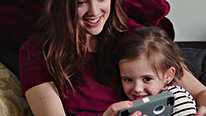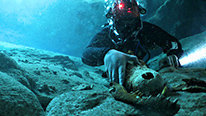- Catherine Haden
- https://www.luc.edu/childrensmemory/haden.shtml
- Professor
- Collaborative Research: Advancing Early STEM Learning Opportunities Through Tinkering and Reflection
- https://www.luc.edu/childrensmemory/childrenslearninginmuseums/tinkeringandreflection/
- Loyola University Chicago
- Tsivia Cohen
- https://www.linkedin.com/in/tsivia-cohen-56555b15/
- AVP Play & Learning Initiatives
- Collaborative Research: Advancing Early STEM Learning Opportunities Through Tinkering and Reflection
- https://www.luc.edu/childrensmemory/childrenslearninginmuseums/tinkeringandreflection/
- Chicago Children's Museum
- Perla Gamez
- https://gamezlab.weebly.com/
- Associate Professor
- Collaborative Research: Advancing Early STEM Learning Opportunities Through Tinkering and Reflection
- https://www.luc.edu/childrensmemory/childrenslearninginmuseums/tinkeringandreflection/
- Loyola University Chicago
- Kim Koin
- Director of Art and Tinkering Lab Studios
- Collaborative Research: Advancing Early STEM Learning Opportunities Through Tinkering and Reflection
- https://www.luc.edu/childrensmemory/childrenslearninginmuseums/tinkeringandreflection/
- Chicago Children's Museum
- Meriem Sadoun
- https://www.linkedin.com/in/meriem-sadoun-30431672/
- Project Coordinator
- Collaborative Research: Advancing Early STEM Learning Opportunities Through Tinkering and Reflection
- https://www.luc.edu/childrensmemory/childrenslearninginmuseums/tinkeringandreflection/
- Northwestern University, Loyola University Chicago
- David Uttal
- http://groups.psych.northwestern.edu/uttal/
- Professor
- Collaborative Research: Advancing Early STEM Learning Opportunities Through Tinkering and Reflection
- https://www.luc.edu/childrensmemory/childrenslearninginmuseums/tinkeringandreflection/
- Northwestern University
Public Discussion
Continue the discussion of this presentation on the Multiplex. Go to Multiplex












Catherine Haden
Professor
We appreciate you taking time to watch our video! Our research-practice team will be excited to hear your questions and feedback about these topics, as well as other connections that you make to our work:
1) How can tinkering design challenges and facilitation strategies support STEM learning opportunities for young children?
2) How to promote STEM-rich reflection on learning after museum experiences?
3) How to collect video and audio data in museum settings that, in turn, informs practice?
Meriem Sadoun
Kenneth Huff
Teacher of Science
Students in the Tinkering Lab seemed engaged in their work. Are there plans to collaborate with other museums in the Chicago area (i.e. Adler Planetarium) to scale up the Tinkering Lab program? Can you please say more about what practices you are seeking to observe as you assess what happens in the Tinkering lab? Are these the same 8 practices of the NGSS? Thank you.
Meriem Sadoun
Catherine Haden
Professor
Thanks for the great questions! We are interested in collaborating and scaling our work. There are great opportunities we have been exploring to do so in Chicago (as you point, out Adler also has a flexible workshop space for young learners), as well as other informal learning institutions elsewhere (e.g., libraries; museums serving families in rural and small towns).
We observe parent-child interactions during tinkering and score the video records using a system we have developed to capture engineering practices as outlined in NGSS and also described by others (e.g., Quinn & Bell in Design Make Play, Honey and Kanter, Eds.). Essentially, we adapt these to what we see with young children and their families in a tinkering exhibit. Our codes include: asking questions and defining problems, using and/or referring to models and/or creations made by staff and visitors to develop ideas, planning and seeing what materials are available, testing creations or parts of creations, math talk, and engaging in reflection, comparison, and evaluations/describing value of experience. Happy to share out our detailed coding system directly with you if you are interested.
Christine Cunningham
preK-12 Science and Engineering Educator
I am interested in the social nature of learning that you mention and support. The tinkering lab seems like a great way to engage groups of peers or families in solving a problem. I’m wondering what sorts of roles you see adults and children take on during these activities, particularly with respect to science and engineering concepts or ideas. Also, the video mentions that the presence of a facilitator who provides tips supports design thinking. Have you seen evidence that the different groups working in the space interact or share knowledge or ideas with one another or do the groups tend to be fairly self-contained?
Tsivia Cohen
Meriem Sadoun
Tsivia Cohen
AVP Play & Learning Initiatives
Thanks for your terrific questions. We've been very interested in the social nature of learning as well. The Tinkering Lab is an example of multi-sided, multi-visitor design, concepts researched by Minda Borun her seminal Curator articles continue to inspire). Mostly we see visitors engaging within groups or families, but they also have the example of what other visitors are doing and how they are interacting. Caregivers tend to promote engineering process by asking questions and encouraging children to test and modify, based on observations. Facilitators will often model these prompts and questions. Adults seem to have the effect of helping children be more methodical and reflective as they tinker. We've been studying the effect of a number of programmatic changes on interactions within families.
Catherine Haden
Professor
We do see families referring to others creations. Sometimes it is creations that have been left behind. Other times it is looking at what others are creating as it is happening, or how things work out for others when they conduct a test (e.g., whether something someone else has made rolls down the ramp).
Facilitators do offer prompts and questions, and we do see parents incorporate some of these into their own natural way of talking with their children. We see more engineering-related talk during tinkering when families have received an orientation from facilitation staff, but it isn't just echoing what the facilitator said, but more talk about the engineering process overall. Also, families are engaging in more engineering related talk when the design of the exhibit provides explicit opportunities for testing (e.g., a ramp, a wind tunnel) than when these testing features are not available in the space.
Sara Lacy
Senior Scientist
It looks like you have been doing some video analysis. Could you describe how you're doing that?
Meriem Sadoun
Catherine Haden
Professor
Yes! We have a terrific set up at Chicago Children's Museum. Families who consent to being part of our research activities are video recorded as they work in the Tinkering Lab. We have several hard wired cameras so we can capture what these families do as they work in the space (e.g., move from a work table to a wind tunnel across the room). The multiple cameras also help us to focus in only on the families we have consented. Families also wear wireless microphones that allow us to hear their conversations during tinkering.
We have developed several coding systems that guide what we are looking for in the video records. We review the records, for example, to determine the frequency with which families engaged in testing their design, and whether after the test they redesign/iterate their design, and who performs the test (parent, child). We find from these analyses, for example, that when the child initiates the test, they are more likely to then move to redesign/iterate their creation compared to when the adult initiates testing. Happy to talk more with you about specifics of video analysis!
Barbara Rogoff
Hi there -- Congratulations! Wondering-- Does the facilitator follow a particular approach?
Kim Koin
Director of Art and Tinkering Lab Studios
Hi Barbara! Thank you for you question! In Tinkering Lab, we are an open all the time, drop in space within Chicago Children's Museum.
Visitors always get a quick introduction which includes introducing ourselves, the challenge and the space. At busier points of the year we've also invited visitors to have an orientation to the challenge, for example, "Make Something that Rolls." This orientation has included science content (for something to roll either the wheel or the wheels/axles need to spin), and modeling and practicing close observation and comparison of examples. "Why does this vehicle roll and this one does not?" "Which creation moves more, why?"
As facilitators we do not follow a script, but we have a set of goals we are striving to reach during our interactions with visitors while being responsive to their needs and interests.
Further posting is closed as the showcase has ended.